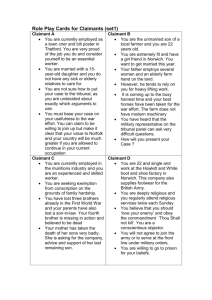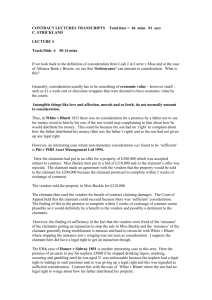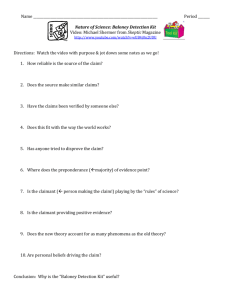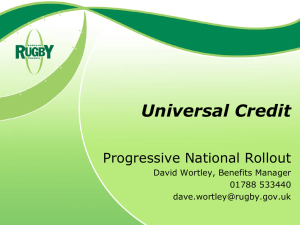Measure 49 Synopsis
advertisement
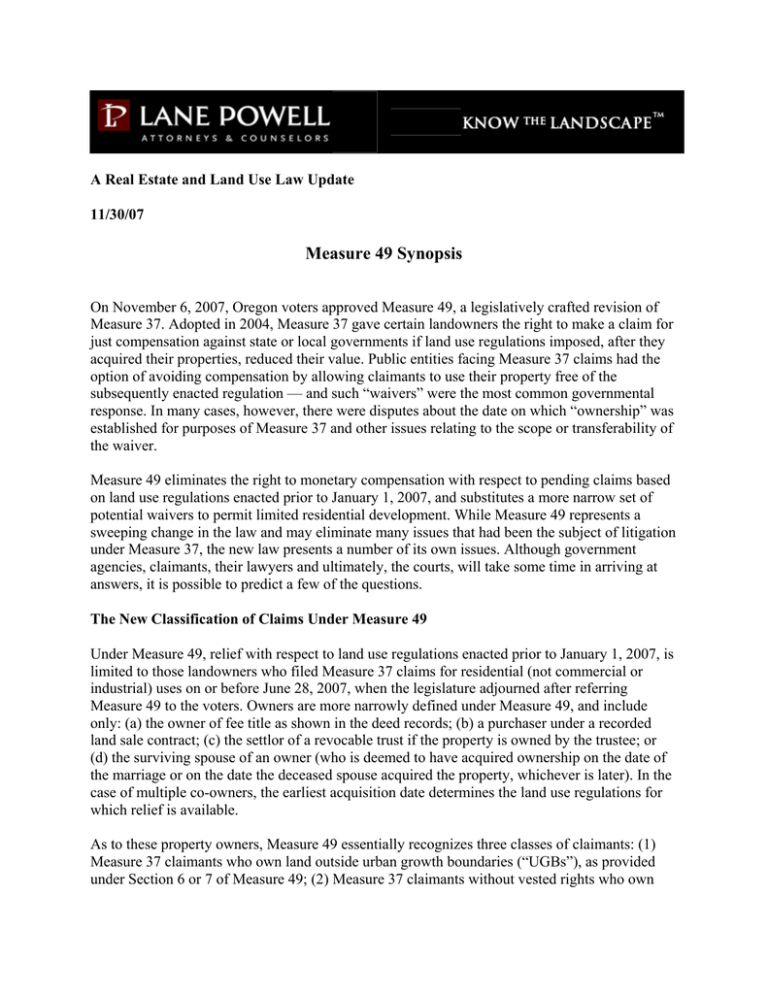
A Real Estate and Land Use Law Update 11/30/07 Measure 49 Synopsis On November 6, 2007, Oregon voters approved Measure 49, a legislatively crafted revision of Measure 37. Adopted in 2004, Measure 37 gave certain landowners the right to make a claim for just compensation against state or local governments if land use regulations imposed, after they acquired their properties, reduced their value. Public entities facing Measure 37 claims had the option of avoiding compensation by allowing claimants to use their property free of the subsequently enacted regulation — and such “waivers” were the most common governmental response. In many cases, however, there were disputes about the date on which “ownership” was established for purposes of Measure 37 and other issues relating to the scope or transferability of the waiver. Measure 49 eliminates the right to monetary compensation with respect to pending claims based on land use regulations enacted prior to January 1, 2007, and substitutes a more narrow set of potential waivers to permit limited residential development. While Measure 49 represents a sweeping change in the law and may eliminate many issues that had been the subject of litigation under Measure 37, the new law presents a number of its own issues. Although government agencies, claimants, their lawyers and ultimately, the courts, will take some time in arriving at answers, it is possible to predict a few of the questions. The New Classification of Claims Under Measure 49 Under Measure 49, relief with respect to land use regulations enacted prior to January 1, 2007, is limited to those landowners who filed Measure 37 claims for residential (not commercial or industrial) uses on or before June 28, 2007, when the legislature adjourned after referring Measure 49 to the voters. Owners are more narrowly defined under Measure 49, and include only: (a) the owner of fee title as shown in the deed records; (b) a purchaser under a recorded land sale contract; (c) the settlor of a revocable trust if the property is owned by the trustee; or (d) the surviving spouse of an owner (who is deemed to have acquired ownership on the date of the marriage or on the date the deceased spouse acquired the property, whichever is later). In the case of multiple co-owners, the earliest acquisition date determines the land use regulations for which relief is available. As to these property owners, Measure 49 essentially recognizes three classes of claimants: (1) Measure 37 claimants who own land outside urban growth boundaries (“UGBs”), as provided under Section 6 or 7 of Measure 49; (2) Measure 37 claimants without vested rights who own land within UGBs, as provided under Section 9 of Measure 49; and (3) Measure 37 claimants who have received waivers and have a common law vested right to complete and continue the use. For land outside the UGB (claimants who filed claims by June 28, 2007), Measure 49 provides the following relief: (i) “Express Lane” – One to three home sites. Under this option, if approved, the claimant receives the lesser of the number of home sites claimed under Measure 37 or one to three home sites outright (including any existing home sites, but allowing for at least one additional home site). To qualify, a claimant must show: (1) ownership and the consent of all co-owners, if any; (2) the right to establish the requested number of home sites when ownership was acquired; (3) that subsequent, non-exempt regulations prohibit establishing the home sites (exempt regulations include those addressing a public nuisance, health or safety and those mandated by federal law); and, (4) that the claim complied with the prior rules for Measure 37 claims; or (ii) “Conditional” four to 10 home sites. Under this option, if approved, the claimant receives the lesser of the number of home sites claimed under Measure 37, or four to 10 home sites (including existing home sites). The claimant must satisfy the requirements for “express lane” treatment (discussed above) and meet a more rigorous set of additional conditions. The property may not be classified as “high-value” farmland or forestland, or be in a ground water restricted area, as defined by Measure 49. The claimant must also submit an appraisal showing a “proven reduction” in fair market value following imposition of the regulation that is equal or greater than the value of requested home sites; or (iii) “Common law vested rights.” As discussed below, Measure 49 provides that a claimant may be entitled to proceed with the development or use allowed pursuant to a prior Measure 37 waiver to the extent that claimant has a “common law vested right” on the effective date of the law (December 6, 2007). For land within a UGB, there is no “express lane” treatment under Measure 49, but claimants who filed claims by June 28, 2007, for residential uses and can meet the more demanding requirements for “conditional” approval (including appraisal requirements) described above, may seek the lesser of the number of home sites claimed under Measure 37, or up to 10 home sites (again, including any home sites already existing on the property). Claimants within a UGB are also entitled to proceed with the development under a prior Measure 37 waiver to the extent that claimant has a “common law vested right” on the effective date of the law. New Claims. New claims (filed after June 28, 2007) are only allowed for land use regulations enacted after January 1, 2007, for residential uses. To qualify, a claimant must demonstrate a “proven reduction in value” by showing that enactment of regulations reduced the fair market value of the property by at least 10 percent. If there are multiple regulations enacted over a fiveyear period reducing the value by at least 25 percent, a new claim may be based on the effect of all those regulations together. “Just compensation” may be payment of money or waiver of regulations and is not transferable. Claims must be filed with the public entity (e.g., state agency, 2 county, city or Metro) which enacted the land use regulation at issue and must be filed within five years of enactment. The Measure 49 Claims Process For most claims under Measure 49, the process will begin with notices to existing Measure 37 claimants by a designated governmental entity. The state Department of Land Conservation and Development (“DLCD”) will process claims outside UGBs (unless the only regulations involved are enacted by a county, in which case the claims will be transferred to the affected county for decision). Local governments (usually cities) will decide Measure 49 claims inside UGBs. DLCD. Within 120 days of December 6, 2007 (April 4, 2008), DLCD is required to send a notice to claimants who have filed Measure 37 claims for property outside a UGB, explaining the claimant’s options. The claimant then has 90 days to elect between the “express lane” (maximum three) or “conditional” (maximum 10) home site claims options. If no timely election is made, the claimant loses the remedy. Local Governments. Within 90 days of December 6, 2007 (March 5, 2008), cities (or, where applicable, other local entities enacting affected land use regulations) are required to notify claimants of their right to seek Measure 49 relief, provide claim forms and identify any information that must be submitted. The claimant then has 120 days to file or lose the remedy. If the local government entity has granted a waiver, it has 240 days to make an initial determination of the extent of any Measure 49 relief that is available and notify the claimant as to the number of home sites, if any, it proposes to authorize. The claimant then has 15 days to comment, and the local government must make its final decision within 300 days of December 6, 2007 (October 1, 2008). Development Permitted. Under Measure 49, lots approved for home sites are restricted to two acres if located on high-value farmland or in ground water restricted areas, or five acres if not located in such areas. New lots in farm and forest zones are required to be clustered to maximize suitability of remnant lots for farm or forest use. Owners are limited to no more than 20 home site approvals regardless of how many properties they own or claims they have filed. Home site approvals are transferable to subsequent owners, with no time limit on when the claimant must carry out the use. However, when a claimant conveys the property, the new owners have 10 years to establish the dwellings and divide the property. A claimant’s entitlements under Measure 49 are not affected by death of a claimant after December 6, 2007, and will pass to heirs who acquired the property. Vested Rights. As noted above, claimants also may be able to complete development that has vested following a Measure 37 waiver, subject to risk of challenge. Measure 49 does not clearly specify how the determination of vested rights is to occur. Initial comments following the passage of Measure 49 suggest that state and local governments view this as an issue to be resolved by local governments or the courts. Counties are required to give DLCD notice of any “Measure 37 permit,” which is defined as any final decision to authorize the development, subdivision, partition or other use of property pursuant to a waiver. The level of investment and development that will establish a common law vested right generally has been determined on a 3 case-by-case basis. This involves consideration of a number of factors, including: (1) the amount of money spent in relation to the total cost of establishing the use; (2) the good faith of the landowner; (3) whether the landowner had notice of proposed regulations before commencing development; (4) whether the expenditures are related to the proposed use or could apply to various other uses of the land; (5) the kind of project, its location and ultimate cost; and (6) the extent to which the acts of the landowner rise beyond mere contemplated use or preparation. This multi-factor, case-by-case determination is likely to result in significant new litigation and, perhaps, significant differences in approach from jurisdiction to jurisdiction. Judicial Review. A decision by DLCD is reviewable under the Administrative Procedures Act which provides for substantial deference to factual determinations by the agency. In addition, although Measure 49 treats the agency’s decisions as orders in an “other than contested case” proceeding (which does not require a hearing before the agency and is reviewed by a circuit court), it limits the record to that created before the agency, and permits appeal only to the extent that the claimant has raised the issue in that forum. County and other local government decisions are reviewable in a circuit court on a writ of review under ORS Chapter 34 — again with significant deference to the local government’s findings, and with the record and issues on appeal limited to those presented to local government. Measure 49 does not provide a clear avenue for the determination of vested rights under a prior Measure 37 waiver, which arguably might be initially determined by a circuit court. If such determinations are made in the context of a local government permit decision, they likely are subject to judicial review in a circuit court. Conclusions Measure 49 is a new statute that has not yet been sustained or interpreted by the courts, and this synopsis should be considered no more than an outline which identifies a few of the many questions to be answered. It is likely that there will be constitutional challenges and other significant litigation over the interpretation of Measure 49, its application to cases now pending in court and to development that is already under way. For more information, please contact the Real Estate and Land Use Practice Group at: 206.223.7000 Seattle 503.778.2100 Portland realestate@lanepowell.com www.lanepowell.com We provide the Real Estate and Land Use Law Hotsheet as a service to our clients, colleagues and friends. It is intended to be a source of general information, not an opinion or legal advice on any specific situation, and does not create an attorney-client relationship with our readers. If you would like more information regarding whether we may assist you in any particular matter, please contact one of our lawyers, using care not to provide us any confidential information until we have notified you in writing that there are no conflicts of interest and that we have agreed to represent you on the specific matter that is the subject of your inquiry. Copyright © 2007 Lane Powell PC www.lanepowell.com Seattle - Portland - Anchorage - Olympia - Tacoma - London 4


